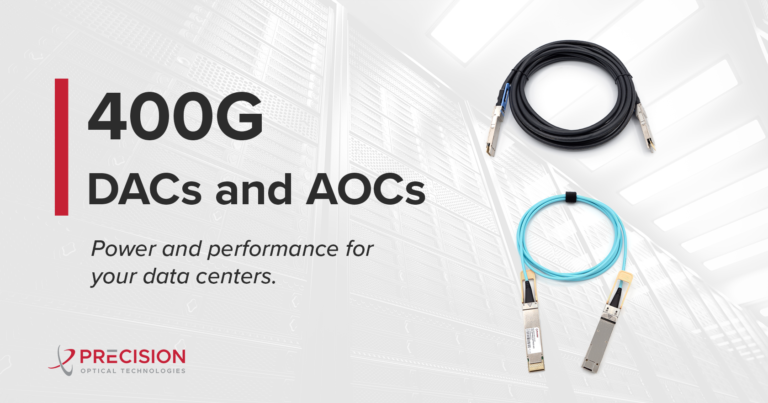
Tips for Your Data Center: Preparing for 400G Server Interconnect

Tips for Your Data Center
The era of 400G is dawning at last, but the question is how fast the market will bloom. The answer is “it depends.” Not every data center operator is ready to leap straight to 400G just yet. But the need is developing, gradually becoming more top-of-mind. For those data center providers that can see a need to upgrade their network architectures, figuring out how the jump to 400G might look is a great place to start. In this blog, we take a look at 400G Direct Attach Cables (DACs) and Active Optical Cables (AOCs) and how you can take steps toward 400G in a way that suits your needs.
Revisiting the DAC/AOC Comparison
Before we get into the discussion of 400G equipment, you can check out a wider discussion of the pros and cons of investing in DACs or AOCs here. In that blog post, we compared both types of cables according to cost, length, durability and signal integrity. Here are a few high-level points to remember:
- Compared to buying individual transceivers and cables, investing in DACs and AOCs saves money and time
- Because they use copper, DACs cost less than AOCs
- Fiber-based, AOCs offer advantages in terms of cable length, but must be handled carefully as they are lighter and thinner than DACs
- Data centers often need both in order to meet different requirements for distance
When it comes to 400G, the story is quite similar, but with certain differences. For one, 400G DACs are much shorter in length than lower bandwidth versions, coming in one, two and three meter lengths. As the length of the cable increases, so too does its thickness. Because DACs use copper, short distances are required to avoid signal losses due to electromagnetic interference. But when it comes to data center server interconnect, 3 meters (or roughly 9 feet) is enough to reach from the bottom to the top of most racks, whether they are in the MSO headend, central office or any kind of data center.
Because 400G AOCs use fiber optic cables for signal transmission, they are more resistant to noise and also have a smaller volume and lighter weight than 400G copper DACs. They can also run longer distances than copper-based DACs – between 70 and 100 meters. At the same time, however, they are priced higher than the 400G alternative, making issues like budget and total cost of ownership critical for data center operators.
It’s also worth noting that, in terms of variants, the 400G DAC offers more choice in breakout cables. Such cables have a QSFP56-DD port on one side and multiple QSFP or SFP ports on the other. They are useful in splitting a 400G signal into 200G, 100G and 50G bandwidths to connect different types of networking equipment (from different vendors too).
Depending on your bandwidth needs, budget and power requirements, both 400G DACs and AOCs are a worthy investment, especially for those data center operators with an eye to the future. It’s important to note, however, that going this route and fully adopting 400G requires a strong financial footing. It is a fairly expensive upgrade for providers to go into 400G all the way. By themselves, DACs and AOCs are just one piece of a much larger digital transformation puzzle. Running 400G requires other new hardware as well.
Incremental Upgrades: Leveraging Backwards Compatibility
Fortunately, there is a way to make a more incremental move toward 400G. Think about it like this – on the journey to 400G, there are two main strategies data center providers can employ:
- Invest fully in upgrading to 400G by purchasing DACs, AOCs, DAC breakout cables and other associated equipment
- Leverage the 400G DAC/AOC QSFP56-DD backwards compatibility with QSFP28 ports for an incremental upgrade
The QSFP56-DD ports of the 400G DAC and AOC models are backwards compatible with the QSFP28. As a result, a customer could purchase this kind of 400G hardware but turn it up at 100G using the QSFP28 ports on existing equipment. The option to fully migrate to 400G can thus be explored more fully at a later date when the need becomes more pressing. The benefit is that the growth-minded data center provider can begin setting themselves up for success immediately. Clearly, there is more than one path to 400G.
Precision OT Supports 400G in the Data Center
When it comes to 400G in the data center, Precision OT is an active player in the market. Offering both 400G DAC and 400G AOC cables, we are ready to support data center operators with whatever unique requirements they have.
Additionally, Precision is also getting ready to offer a 400G DAC breakout cable that uses a single QSFP56-DD transceiver connected to four QSFP28 endpoints. With this cable, data center technicians can connect a single 400G port to four different pieces of equipment to achieve a 400G to 100G network connection. As always, we test these cables in our engineering labs to ensure you are offered equipment of the highest quality.
Do you need to make the leap to 400G now or at some point in the future? If so, let us know – our team of network engineers can answer your questions.






